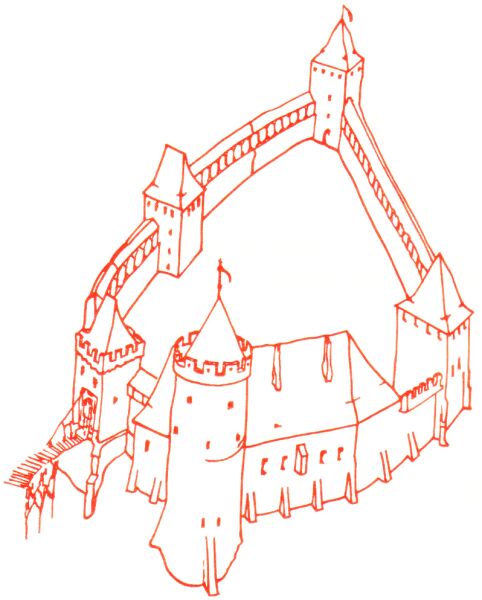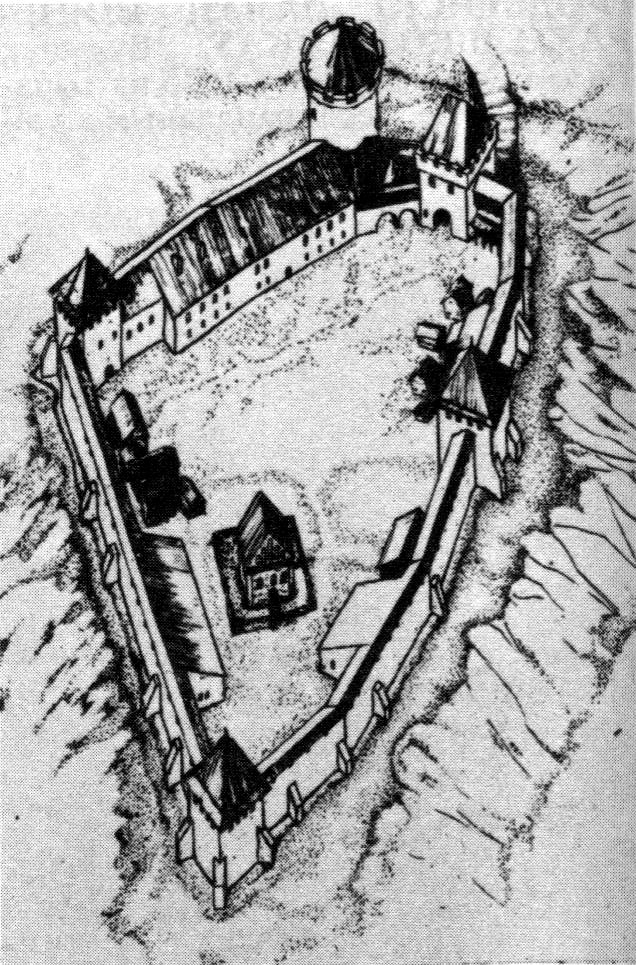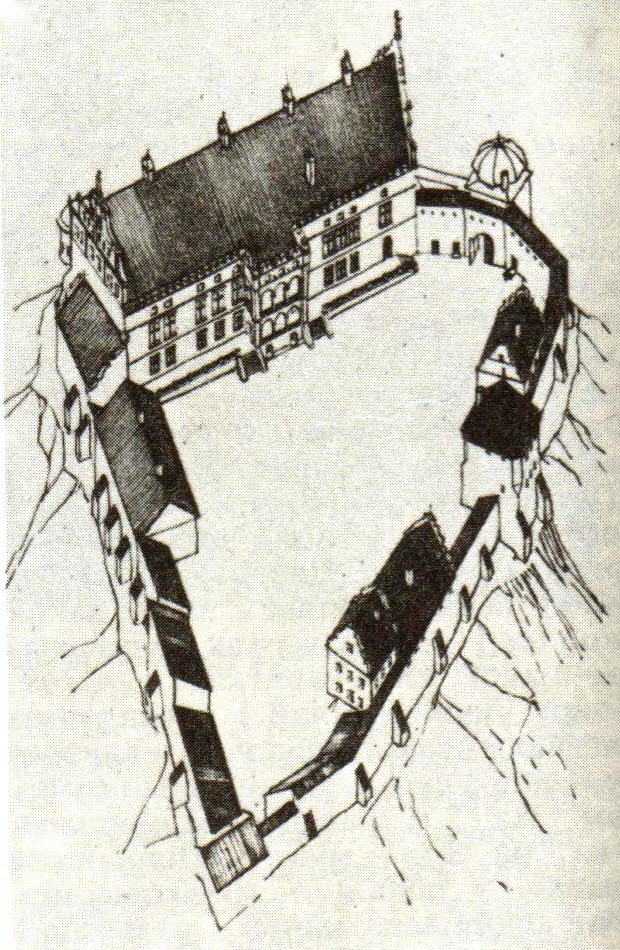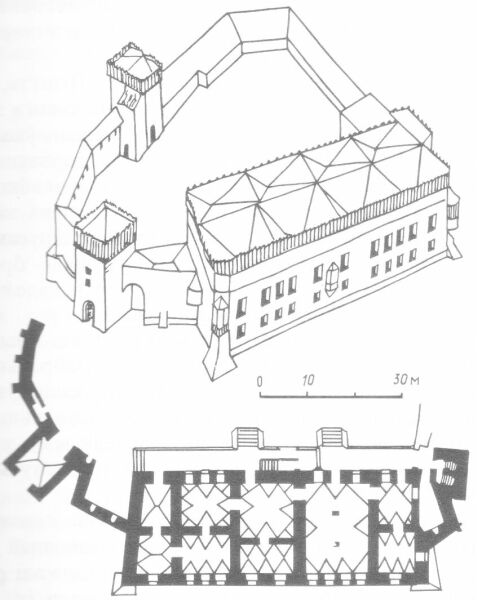 Hrodna Old Castle
Hrodna Old Castle Hrodna Old Castle
Hrodna Old Castle
Hrodna Old Castle was build where a smaller river - Hradnichanka - merges with Nioman river. A tall hill with steep 50m slopes was naturally inviting to build a castle there. The Castle hill was surrounded at the edges with tall 15m wide soil rampart. The rampart was fortified with oak and pine logs burried inside it. There were two churches - 12th century Lower Church and Vitaut's XV c Upper Church - inside Hrodna Old Castle. The colorful majolic floor of the Lower Church has survived till present days. The hills were strengthened with stones. At the top of the rampart log walls were built with shooting galleries. The only connection to the land was through the bridge over a deep moat. The castle became Duke's residence in early XII century and Hrodna itself became a center of feudal Duchy. Dukes 2-story palace was built inside. The North-Eastern wall was simultaneously the wall of Duke's Palace. In XIII century Ipatiev Chronicle states that the castle had powerful gates protected by a round tower of a "stolp" or Valyn' type.
 XIV-XVI centuries
XIV-XVI centuries
After a big fire in 1398 Grand Duke Vitaut The Great has built a
stone castle in place of wooden Old Castle. The gigantic work that went into this
has proved itself useful. Vitaut castle withstood 150 years of violent military sieges
before falling. 4 new square towers were added by Vitaut the Great around the perimeter.
The round "stolp" tower was the fifth tower. The Old Castle Gates were essentially a
square tower with wooden chain bridge. The stone walls were reaching 3m in width. The
characteristic to the region masonry technique used layer of bricks on top of each layer
of big boulders to even out the layers forming stone-brick sandwiched walls. Pretty good
technique - see me standing on this wall
after 600 years of wars enflaming the region. I was born in Hrodna.
First time that I remember visiting Old Castle I was in first grade. I was absolutely
excited with Napoleon cannons at the entrance - Napoleon's army has drown them while
crossing Nyoman. There is a Museum of Natural History and Archeology in the castle
nowadays. One can see reconstructions of early Earth landscapes filled with mysterious and
strange creatures. Historical halls exhibit knights armor and archeological finds. A 700
year old Teutonic saw-like dagger with "Drink Blut" words written in Gothic
letters along the blade. I hope this was a trophey brought into Hrodna castle by Vitaut
the Great - Duke of the Grand Duche of Lithuania - on his return from Grunwald battle,
where he had drowned blood thirsty teutons in their own blood. There are images and
taxodermic copies of most of our animals. Several halls are devoted to history of
Byelorussian Soviet Socialist Republic, a heroic gorilla resistence of Belarusians during
WWII. I often visited Old Castle walking in the evenings. There is a nice view of the river from it's wall.
And every time I stand on this powerful wall I feel proud of my ancestors.
 XVII - XVIII centuries
XVII - XVIII centuries
The Palace was rebuilt in 1580 by Italian architect Scot from Parma for the King of Recz Paspalita of Poland and Lithuania - Scyapan Batory. The Renaissance palace (60 x 21 m) stands on the foundation of the earlier Gothic Vitaut Palace. The thick (up to 2.35m) outer walls that are used as castle walls were damaged my Muscovites cannon shots in 1655. They were rebuilt in XVIIIc. At this later time extra inside walls were added too.

First floor has 10 rooms. It had Grand Hall, several household storage rooms, archive, cellars, rooms for guards and servants. The second floor was occupied by King Batory himself. According to the description of 1653 it had - hall with big stairway, entrance hall, dinner hall, small lobby, room "from town side" with an alcove, third side room, room for "drabats" - body guards, room "facing sunrise on town side", which was King Batory's bedroom. It is here King Scyapan Batory died in his bed on December 12, 1586. All rooms at the second floor are of typical palace anfilade plan. This Palace was an important political center. It has received ambassadors of Ivan the Terrible and Polish Soim. In 1705 it is here that Peter the Great of Russia and August II made a union against Karl XII. In 1708 Swedish king had captured town of Hrodna and blowed up the Old Castle. After Swedes have left August II has given the survived part of Old Castle to lower members of his Chancellory. He himself has moved into Sapega Palace (accross Jesuit Cathedral) that he exproriated from Sapega Family for their participance in faction opposing Augiust II.
Photos:
References:
"Arhitektura Belarusi. Encyklapedychny davednik" ed.: A.A. Voinau and others, Minsk, Publishing House "Belaruskaia Encyklapedyia" named after Piatrus' Brouka, 1993. ISBN 5-85700-078-5.
"Hrodna and Monuments of Panyamonnie" ("Hrodna i pomniki Paniamonnya") by L.V. Aliakseeu, Publishing House "Belaruskaia Navuka", Minsk 1996. ISBN 5-343-01410-0.
Back to Hrodna tour or Belarusian Castles and Knighthood
 This file is a part of the Virtual
Guide to Belarus - a collaborative project of Belarusian
scientists and professionals abroad. VG brings to you the most extensive
compillation of the information about Belarus on the Web.
This file is a part of the Virtual
Guide to Belarus - a collaborative project of Belarusian
scientists and professionals abroad. VG brings to you the most extensive
compillation of the information about Belarus on the Web.
Please send your comments to the authors of VG to
Belarus
History | Statehood | Culture | Law
and Politics | Cities | Nature and Geography |
©1994-03 VG to Belarus
Disclaimer